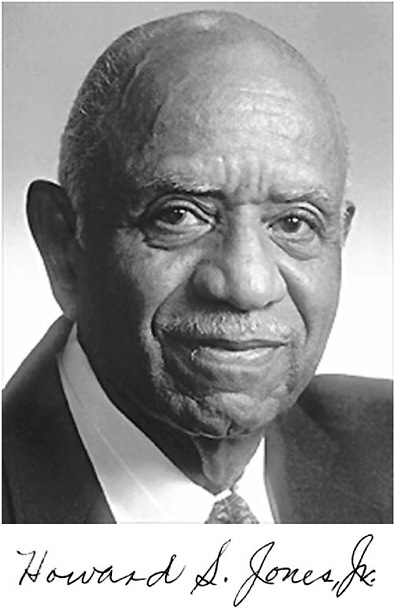HOWARD ST. CLAIRE JONES JR.
1921–2005
Elected in 1999
“For the invention and development of antennas and microwave components for missiles and spacecraft.”
BY JOHN BROOKS SLAUGHTER
HOWARD S. JONES JR., an engineer, scientist, and inventor who was renowned for his work on radar and communications antennas and systems, died on February 26, 2005, at the age of 83. At the time of his death, he was an independent consultant in microwave electronics, a field in which he had made significant technical contributions.
Howard Jones was born on August 18, 1921, in Richmond, Virginia. He received his education in that city culminating with a B.S. in mathematics and physics from Virginia Union University in 1943. He received a Certificate in Engineering from Howard University in 1944 and an M.S. in electrical engineering from Bucknell University, Lewisburg, Pennsylvania, in 1973. In a career that spanned more than 60 years, Howard served in the military, in academe, in the corporate world, and in government. An internationally recognized expert on microwaves and radar antenna systems, Howard was elected to the National Academy of Engineering in 1999.
After two years in the army during World War II, Howard went to work as an electronics physicist with the National Bureau of Standards, later the Harry Diamond Research Laboratories of the U.S. Army Laboratory Command, in Adelphi, Maryland. During his 34-year tenure there, he was a prolific inventor who received 31 patents for microwave antennas, electronic compo-
nents, and test equipment for missile fuses and radar systems, as well as instruments for military and space applications. During his last 12 years at the Harry Diamond Laboratories, Howard was a supervisory physical scientist and chief of the microwave and research development branch. He retired in 1980.
Howard’s first patent was for an “antenna testing shield,” a device still used today to test the fusing system for missiles under conditions similar to those encountered in operation. His most important patents were for small, lightweight, reliable conformal array antennas that could be enclosed within a missile. Today, conformal antenna arrays are used in nearly every modern U.S. missile, and the technology developed for them laid the foundation for the development of aircraft and missiles that are difficult, if not impossible, to detect by radar. In addition to these inventions, Howard designed and developed state-of-the-art microwave antennas, electronic components, and devices that could be used in a wide range of weapons and communications systems. Although much of his work was done under the auspices of the U.S. Army, he was a strong believer in technology transfer and looked for opportunities to use his inventions and developments in the commercial arena.
Although Howard Jones was an advisor and consultant to the U.S. armed services for more than 20 years, he also participated with university and industry researchers working on many facets of microwave and antenna technology. He published more than 40 technical articles in the scientific and technical literature, made many presentations at national and international conferences, and was an invited speaker at many universities and meetings of professional societies.
Among his many awards were honorary doctorates from Virginia Union University and Trinity College. He was a fellow of the American Association for the Advancement of Science and Institute of Electrical and Electronics Engineers (IEEE), which bestowed upon him the prestigious Harry Diamond Memorial Award (1985), fitting recognition for his years of dedicated service to the safety of our nation.
Howard Jones loved working with young people, and he encouraged them to study math and science so that they could
pursue careers in engineering. He loved what he did and took great pleasure in sharing the joys and opportunities of engineering with students. He was particularly interested in helping minority young people to study engineering, and he spent many hours mentoring and tutoring them for that purpose. He was a kind and generous person who took great pride in his achievements and had a strong desire to see others be as accomplished and happy in their careers as he was in his. Howard resided in Washington, D.C., with his beloved wife, Evelyn.





